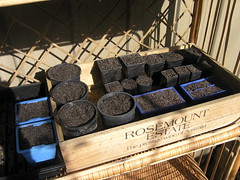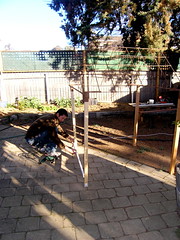Having picked our lovely fresh beetroot while still small, I made the following salad. You might like to try it and let us know what you think!
INGREDIENTS
Bunch small sized beetroot (enough for your hungry friends, say 4-6 small ones each).
Zest of half an orange.
Juice of half an orange (double if making large salad).
Handful of fresh flat leaf parsley.
Half handful of fresh mint.
Good feta cheese (goats feta is ideal), depending on your taste for cheesiness.
Good light olive oil.
Red wine vinegar (optional).
Salt and cracked black pepper for seasoning.
METHOD
Clean beetroot add to saucepan with water and sprinkle of salt and bring to a gentle boil. Cook until just soft when pierced.
Drain and rinse with cold water. At this point you can gently rub off the outer skin, but I don't bother.
Add to salad bowl with orange juice and zest, olive oil, crumbled feta and herbs. Mix gently and check for seasoning, adding salt and pepper to taste. Just prior to serving you could add a light sprinkle of red wine vinegar.
Serve immediately and enjoy!!
- Posted using BlogPress from my iPhone
Saturday 12 December 2009
Want to make a beetroot salad?
Sunday 15 November 2009
You say potato...
A work colleague asked me why her potatoes were hollow in the middle with a dry black soot inside. I suggested it might be a nutrient deficiency. It prompted me to look up potato problems and this is what I found.
Hollow heart occurs when potatoes grow too fast because as a result of too much water or too much fertilizer. Cavity can be discolored and lined with powdery decay, verticillium fungus. Cut away the brown areas before using. Fertilize plants early when tubers are about to form. Avoid planting varieties that develop hollow heart: Chippewa, Katahdin, Mohawk, Irish Cobbler, Sequoia, Russet, White Rose.This webpage also covers a range of other problems, although not in great depth.
As always I checked the Gardening Australia website, but alas nothing specific about potato problems. Then I found this PDF (American), which again is somewhat general, but gets you on the right track to ask your local nursery about some solutions, depending on your problem.

Our potatoes in tubs have popped up nicely and look healthy and green. I just hope hollow heart won't be a factor, as the tubs contain a good deal of compost. I guess we'll just have to see.
By the way, if you're looking for a way to grow potatoes in a small space, you might like to see what Josh Byrne set up; it's a potato cage!
Posted by
Marg
at
Sunday, November 15, 2009
0
comments
![]()
Labels: disease, nutrients, potatoes, spring, spring2009, tubers
Sunday 8 November 2009
Catch-up planting for Spring
Simon bought some tomato seedlings this week: a black Russian, beef steak and some Roma seedlings. We've popped them in with a light sprinkling of lime.

Also got some potatoes going. We ran out of garden space so have 3 tubers in a foam box and a plastic crate! Hopefully they'll do okay.

Planted them with lots of compost and sugarcane mulch. Am hoping they won't be "overcooked" and end up with hollow, black centres! We shall see.
I have also just planted some marigold seeds around our orchard trees - apple, plums, olive. A good companion plant that brings in helpful bugs.
The weather is starting to heat up now with this week in the high 20s to 30s.
- Posted using BlogPress from my iPhone
Saturday 17 October 2009
Mulching up a swale
Did a bit more mulching today and Simon built up a swaleso as to catch more run-off especially around the gate.
The are doing so well we've done a second lot of divide-and-transplant with them. They look fab!
Here's a little pic outlining the swale.
Tomorrow is another sunny day!
- Posted using BlogPress from my iPhone
Monday 5 October 2009
Understanding horseradish
Here's our first piece of harvested horseradish! Our friends John and Jess gave us this horseradish to look after and it's doubled in size in about twelve months. The smell is amazing! It's quite herbacious compared to the processed kind. I read that the longer you let a cut piece oxidize, the more fiery the taste.

I also found a cranberry relish recipe which uses a bit of horseradish, so will give that a go. Ah, that nose-clearing sensation!
Friday 2 October 2009
Technology comes to Hackett
Warning: this is not gardening related!
I bought an iPhone just the other day, which means I have big plans for recording what we are doing in the garden! I've downloaded a blogger app and a photo blog app to be able to capture our hardening activities and post them quickly without too much double handling. As you can imagine with a one year old, that's pretty ideal!
So this is my first iPhone post with many more to come!
- Posted using BlogPress from my iPhone
Saturday 5 September 2009
Spring vegies: carrots, snowpeas and beetroot
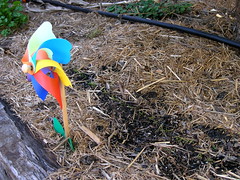 Remember the seeds we propagated this time last month? Well, the snowpeas are now planted out. Around the same time last month, I put in some carrot seeds and they've sprung up well too.
Remember the seeds we propagated this time last month? Well, the snowpeas are now planted out. Around the same time last month, I put in some carrot seeds and they've sprung up well too. Today we planted some beetroot seeds; organic 'Detroit' variety. Last season we put in some baby beetroot which went off - so let's see how these ones go. We planted these in our middle bed, where we had the green manure crop. We dug this in about two weeks ago, so hoping the beetroot doesn't fork out underground!
Today we planted some beetroot seeds; organic 'Detroit' variety. Last season we put in some baby beetroot which went off - so let's see how these ones go. We planted these in our middle bed, where we had the green manure crop. We dug this in about two weeks ago, so hoping the beetroot doesn't fork out underground! Did a round of native fertilizer on our shrubs and grasses - hoping for some ran later in the week (fingers crossed but looking warmer than first forecast). The prunus is in full flower as are our plums.
Did a round of native fertilizer on our shrubs and grasses - hoping for some ran later in the week (fingers crossed but looking warmer than first forecast). The prunus is in full flower as are our plums.
Spring has most definitely sprung!
Posted by
Marg
at
Saturday, September 05, 2009
0
comments
![]()
Labels: beetroot, carrots, snowpeas, spring2009, vegetables
Sunday 16 August 2009
Seed Propagation
Bit of clear plastic for colder nights, shade cloth for sun protection and water tank next door! Receives warmth from the garage wall onto which it backs.
Rollover the pots in the picture (if you click the image and return to Flickr) to see what we've planted. Snowpeas, rocket, raddichio, basil (annual), chicory, and spring onions. Just used a seed raising mix and watered in a very diluted compost tea. Experts say seaweed emulsion is a good starter tonic.
Some of these failed miserably last season (too hot I think). Better luck this year we hope!
Hope to try tomatoes and corn this way too. Perhaps eggplant too.
Monday 20 July 2009
A simple shade house
Simon knocked up a frame for it on the weekend with pieces of timber we had in the garage (it pays to not be too eager to throw things out!).
A bit of shadecloth and gardening plastic should do the trick to cover it. We have some orchids that need a bit of TLC and this will be their home for starters. Also the galangal, lemongrass and other frost-tender things could better survive the winter months under cover.
Why, Clancy could even use it as a playhouse if it doesn't get used for our gardening projects! :o)
Posted by
Marg
at
Monday, July 20, 2009
0
comments
![]()
Labels: building, frame, frost protection, projects, shadehouse
Rainwater tank off garage roof
It's just a 500L tank to help with the summer watering and to complement our little greywater set up (which holds about 100L).
This was a quick 1 day job once we'd bought the fittings, brackets and tank. It's sitting on a wooden pallet. We added a hole to the lid and covered it with a double layer of gutterguard to stop rodents, etc from entering the tank. Not sure if we'll end up with a mozzie problem - something to keep our eye on I suppose. We also put gutterguard along the gutter - of course. :o)
The cost?
500L tank = $99
90mm pipe (x2) = $22
Pipe fittings = $10
Gutterguard (8m) = $3
Brackets = $12
TOTAL = $146
Not bad hey? Off to do a rain dance now :o)
Posted by
Marg
at
Monday, July 20, 2009
0
comments
![]()
Sunday 19 July 2009
Pruning blueberries and other fruit trees
Another lovely Sunday in Canberra in the winter. The sunrise this morning was a sight to behold - looking up to Mt Majura where the clouds were pink and soft dark blue as the sun rose to paint them! Just gorgeous! It's possibly the best time of year for sunsets and sunrises I think.
We pruned our plum trees today - photos to come shortly on our Flick page. Simon found a great interactive PDF guide from Flemings in Victoria on pruning - most useful guide I've seen to date.
I also did some quick research on pruning blueberries and found this from Growing Wisdom. There are other short informative videos too. It's hard not to go past Gardening Australia and the info on their website, particularly as it relates more to our own climate and seasonal cycles!
Posted by
Marg
at
Sunday, July 19, 2009
0
comments
![]()
Labels: blueberries, plums, pruning, video, winter, winter2009
Tuesday 16 June 2009
Canberra Organic Growers Society (COGS) goes online
 The Canberra Organic Growers Society (COGS) started in 1977 and is still going strong. They have a new website up and running, making the most of the flexibility of WordPress - lovely work!
The Canberra Organic Growers Society (COGS) started in 1977 and is still going strong. They have a new website up and running, making the most of the flexibility of WordPress - lovely work!
I've added them to the sidebar under 'Companion plantings', as well as to my RSS reader.
Now to finish reading the Winter edition (2009, Vol 17 No 2) of the COGS newsletter, on crop rotation and tips for winter plantings!
Posted by
Marg
at
Tuesday, June 16, 2009
0
comments
![]()
Labels: Canberra, Canberra_Gardener, COGS, organic
Tuesday 2 June 2009
Heading into winter: things to do
Can't talk, studying! That's the sound of an M.Ed student in the final throws of study for the Spring semester, as we move into the twilight that is winter. I love winter, I'm a winter baby!
Have one last assessment piece to do for the semester then I'm free! :o)
I also have a growing list of things to do in the garden after I've submitted my essay, and I can't wait:
- Pick lemons and preserve them, ala Stephanie Alexander or others style (and noting other's successes/failures)
- Read up on caring for blueberry shrubs (especially for winter)
- Rake up autumn leaves, twigs, bits, etc and add to compost
- Convert makeshift 'piece of tin' into a lid for compost
- Install rainwater tank to supplement greywater tank (if it EVER rains that is)
- Think of a creative use for the remaining 'brickie's' sand pile (any suggestions folks?)
More after the semester ends! :o)
Posted by
Marg
at
Tuesday, June 02, 2009
0
comments
![]()
Labels: jobs, projects, things_to_do, winter, winter2009
Sunday 10 May 2009
Saturday 9 May 2009
Two years on...how are we doing?
We are just over two years in our place in Hackett so today I walked around and took some pics of our garden to see how things have come along. Certainly the backyard is changed completely, the progress is documented in pics over at our Hackett Gardener Flickr set.
First our olive, planted back in June 2007. Here's then:
And now:
Our side verge is looking healthy now the natives (including grasses) has taken off: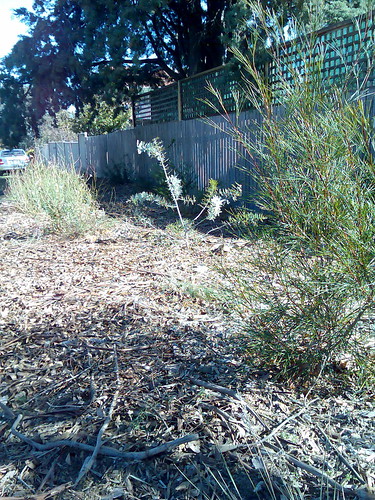
We also added a heap of Poa grasses and dug a swale to try to stop the water run-off into our driveway (which gets to at least an inch deep at times! WE've had a couple of decent downpours since, and the result is pretty good.
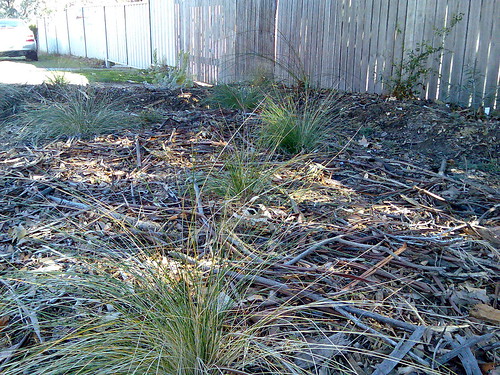
And finally, our pond, now complete with juncus rushes and some new fish too. From this: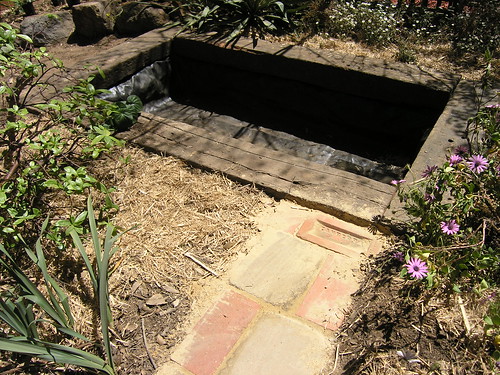
...to this: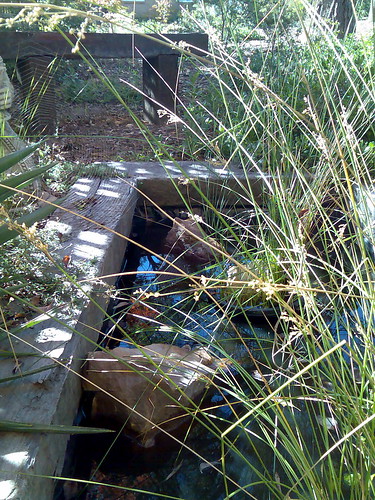
Just a few highlights. Finally, the weeping apricot we planted when Clancy was born is almost 12 months as well - July is the month. It's almost about to drop its leaves for winter. Will mulch it and dose it with some manure just for luck.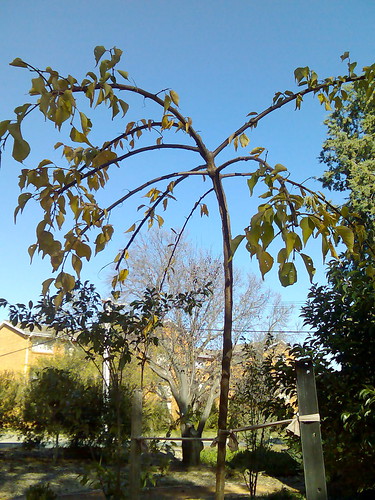
Posted by
Marg
at
Saturday, May 09, 2009
0
comments
![]()
Labels: gardentime 2years two-years natives trees development growth
Rubbish Free Year Challenge | Be The Change
Was reading about these guys in ReNew magazine (Issue 107, Apr-Jun 2009). Not as easy as it seems given the amount of packaging that comes with goods these days.
It has made me think more about the Reuse concept though - recycling is great of course, but if you can reuse before needing to recycle, you are already decreasing the need to expend energy on recycling in the first place. And if you can reduce you will have less to reuse and recycle in the first place.
So, in our garden, I'm attempting to grow our own seed where possible. Parsley, fennel, spring onions, and self-seeded spinach are among the first lot. I didn't know if the parsley seeds would take but they have. The srping onions were a pressie from a friend who had planted seeds herself. The self-seeded spinach can be transplanted when a little bigger, but we're not fussed if we don't get around to it!

parsley seedlings
I kind of like the mentality that if we don't want to worry about weeds and things then we can focus more on planting things that we don't mind reseeding themselves in place of weeds. Weeds are only plants in the wrong place anyway, right? :o)
Simon did a round of mulch and manure with a touch of lime a couple of weekends ago and we also planted a green manure patch of peas which have just started to sprout. We also have some broad beans that have just sprouted too, so will put in a second lot (dwarf this time) and see if we get staggered crops this time.
Have also got advice on our strawberries (sms from my dad the expert: "Looks ok gd luck") and that we should move them for more frost protection and more fertile soil. They were sitting out the front and weren't getting the same attention as the vegies out the back, so it was time to move them.
Gardening Australia also had a segment on recently about using tubes of newspaper to plant seedlings. Egg cartons work well for things like lettuce and herbs if starting them from seed.
Water is the big one though - reuse is ideal if you can set up a greywater system of some sort. Ours is working a treat since we put one together about 2 years ago now.
The next phase woudl be to set up a seed-raising area, protected from the extreme weather. Behind our shed would be good. Now to make some time to do it! A gardener's work is never done.
Saturday 28 March 2009
Earth Hour: What are you doing?
As we've just heard on the local radio, Canberra has only had one-third of its average rainfall and dams are barely 50% full. It's good to stop - even for an hour - and reflect on where we are in terms of climate change. Our garden is sooooo dry right now! Even our little desert lime looks stressed!
We're having a candlelit dinner for two while our daughter, Clancy, sleeps blissfully unaware of the world and its problems around her. So, what have you got planned for Earth Hour?
Posted by
Marg
at
Saturday, March 28, 2009
0
comments
![]()
Labels: climatechange, earthhour, future, planet, voteearth
Sunday 22 March 2009
Take 2: Kamal Meattle on how to grow your own fresh air
Kamal Meattle on how to grow your own fresh air
OK, so in addition to the video I blogged yesterday, and in response to a couple of comments, here's a screenshot of the three plants Kamal refers to in his talk.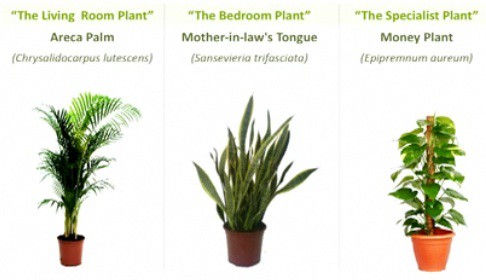
I should have also mentioned that the video is just under 5 minutes, for those who like to know!
I did some more searching and found more of a 'list' of 'greening and cleaning' indoor plants from Tricia Edgar at Houseplants:
Dr Bill Wolverton, a former NASA scientist who conducted 25 years of research on indoor plants and their ability to purify air in enclosed environments, wrote the book How to Grow Fresh Air (Penguin, 1997) which describes 50 plants that clean office air. These plants include:
- Corn plant (Dracaena Massangeana)
- English Ivy (Hedera helix)
- Gerbera daisies (Gerbera jamesonii)
- Golden pothos (Epipremnum aureum)
- Madagascar Dragon Tree (Dracaena)
- Peace Lily (Spathiphyllum)
- Rubber plant (Ficus elastica)
- Spider plant (Chlorophytum comosum)
- Sword or Boston fern (Nephrolepis exaltata)
- Weeping fig (Ficus benjamina)
Read Tricia's full article.
For more discussion on the use of office plants, you might like to check out Green Building Council Australia. Their premise is that there is no such thing as 'indoor plants' and plants work hard to survive indoors, but some are more able to adapt than others.
And, if you're still not sure, just got and pick a fresh bunch of flowers to brighten up your (indoor) day! :o)
Posted by
Marg
at
Sunday, March 22, 2009
0
comments
![]()
Labels: fresh_air, green_office, indoor_plants, TEDtalks, video
Saturday 21 March 2009
Kamal Meattle on how to grow your own fresh air
Kamal Meattle on how to grow your own fresh air | Video on TED.com
A simple but effective approach to greening up your office, home or other spaces regularly used.
I work in an open-plan shared office space on the first floor of an old building where our air conditioning is always on (cooling or heating) and often is not well regulated. While we still have the capacity to open windows for fresh air, I tend to notice at the end of a day in the office, that I feel 'out of sorts' (although some would attribute that to my role no doubt!), with dry eyes and skin, and feeing lethargic and 'stale'.
It might be worth taking up Kamal's ideas here are seeing how things might change!
Friday 23 January 2009
Locally owned and operated
I've really enjoyed the remainder of my maternity leave in my hometown back in Western Australia; it's shown me how the South West region has progressed, particularly when it comes to local produce. Much of the region has been farmed using conventional methods, from cattle (meat and dairy) to potatoes and caulies, and in more recent times, vineyards, avocados, and a range of vegies for the Perth and overseas markets. In the Lower South West, marron and trout farming have long been successful, again with overseas markets adding to the demand, as has some more recent innovative farming and value adding practices, including many accommodation options. One such innovative venture is called Holy Smoke; a small business owned and operated in Manjimup. The business began as a one-man operation, and has grown into a slick operation where products are now gracing Perth supermarket shelves.
"So?" I hear you say? Well, in the 10+ years I've been living away from the area, I've noticed much more of these innovations this summer! Holy Smoke is just one example. Another is the award winning Bannister Downs, a Northcliffe based dairy which packs its own milk in recycled material, along with producing and packaging its own cheeses, creams and flavoured milks - all this from the dairy - the primary producer, cutting out the "middle man". Not only do Holy Smoke and Bannister Downs add value to a primary product, they are marketing with 'local' firmly at the centre. 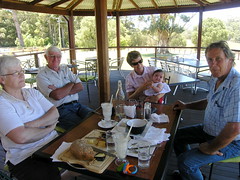
![]()
![]()
Holy Smoke has a small deli in the neighbouring town of Pemberton where customers can try the produce via delicious freshly made gourmet rolls - I tried the bird lovers roll which contains smoked duck and smoked chicken with fresh salad. The fish lovers roll is also popular and contains smoked trout and marinated prawns. The deli stocks regional products from Margaret River, Manjimup and other surrounding towns, showcasing the best of local cuisine in a highly accessible fashion. I bought my partner a bag of goodies for his birthday - isn't that the best promotion of local goods?!
![]()
![]()
Likewise, Bannister Downs milk can be found on the shelves of the local supermarkets and is competitively priced. My own parents prefer it to the bigger milk packaging companies. The pride in 'buying local' as well as 'producing local' is well and truly alive. It is also a huge drawcard for tourism to the area, where operators can team up with accommodation ventures to offer a broader local experience which ensures visitors not only eat local but engage the local services and can tell of their local experiences to others, perpetuating a trend of holidaying 'locally', so to speak.
In the current economic climate it is satisfying to see local business and local communities pull together innovative practices and sustainable processes to hopefully withstand the downturn impacting the globe. If we take care of a local areas by buying and producing locally, we can go some way to ensuring the long term health and wellbeing of our precious communities.

